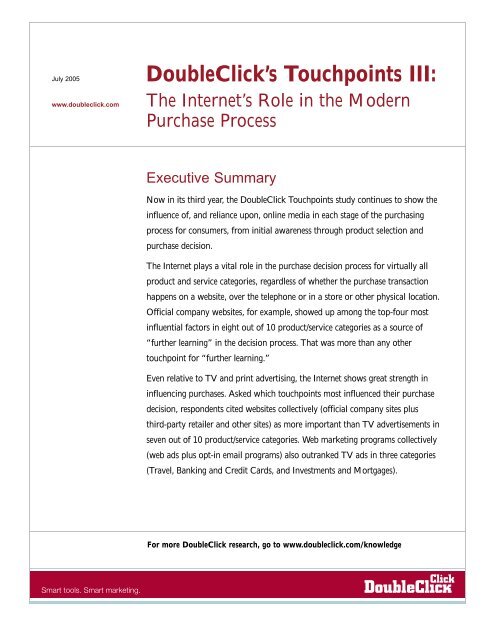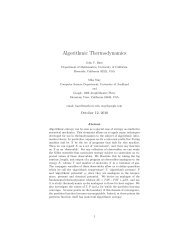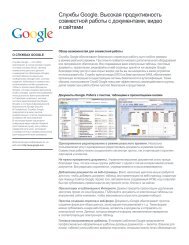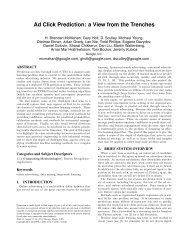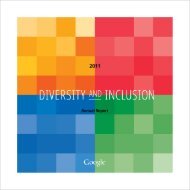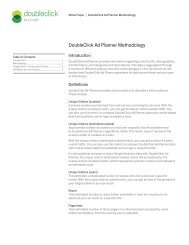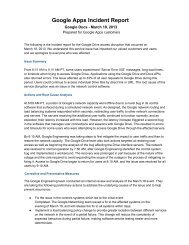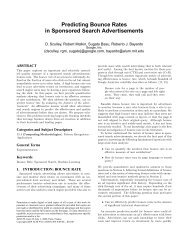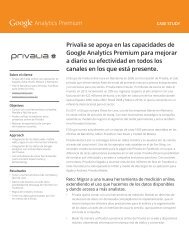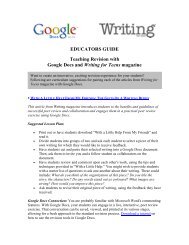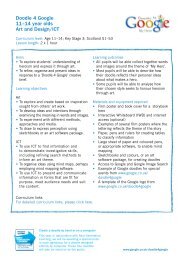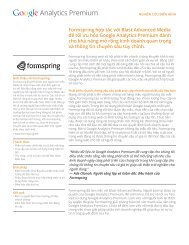DoubleClick's Touchpoints III:
DoubleClick's Touchpoints III:
DoubleClick's Touchpoints III:
- No tags were found...
You also want an ePaper? Increase the reach of your titles
YUMPU automatically turns print PDFs into web optimized ePapers that Google loves.
July 2005www.doubleclick.comDoubleClick’s <strong>Touchpoints</strong> <strong>III</strong>:The Internet’s Role in the ModernPurchase ProcessExecutive SummaryNow in its third year, the DoubleClick <strong>Touchpoints</strong> study continues to show theinfluence of, and reliance upon, online media in each stage of the purchasingprocess for consumers, from initial awareness through product selection andpurchase decision.The Internet plays a vital role in the purchase decision process for virtually allproduct and service categories, regardless of whether the purchase transactionhappens on a website, over the telephone or in a store or other physical location.Official company websites, for example, showed up among the top-four mostinfluential factors in eight out of 10 product/service categories as a source of“further learning” in the decision process. That was more than any othertouchpoint for “further learning.”Even relative to TV and print advertising, the Internet shows great strength ininfluencing purchases. Asked which touchpoints most influenced their purchasedecision, respondents cited websites collectively (official company sites plusthird-party retailer and other sites) as more important than TV advertisements inseven out of 10 product/service categories. Web marketing programs collectively(web ads plus opt-in email programs) also outranked TV ads in three categories(Travel, Banking and Credit Cards, and Investments and Mortgages).For more DoubleClick research, go to www.doubleclick.com/knowledge
DoubleClick’s <strong>Touchpoints</strong> <strong>III</strong>: The Internet’s Role in the Modern Purchase ProcessObjectivesThe DoubleClick <strong>Touchpoints</strong> study serieswas designed to gain a greaterunderstanding of how consumers makebuying decisions for the products andservices they purchase, and how theInternet is changing that decision process.DoubleClick first executed this survey inDecember 2002, and the methodology hasremained consistent since then. In a webbasedsurvey recruited from the researchpanel of Greenfield Online, DoubleClickand ROI Research asked 2,110 U.S. adults(aged 18+) in December 2004 about theirpurchases over the previous six monthswithin the following 10 categories:Automotive, Consumer Electronics, CreditCards and Banking, Home ImprovementProducts, Investments and Mortgages,Movies, Personal/Home Care, PrescriptionDrugs, Telecom Services and Travel.The survey focused on three distinctphases of the purchase process: InitialAwareness (“How did you first learnabout the product/service…”); InformationThe Purchase Decision FunnelGathering (“How did you further learnabout the product/service…”) andPurchase Decision (“Which of thefollowing most influenced yourdecision…”). (Figure 1)For each of these phases, the survey askedrespondents to choose among 14 (or more,depending on the product category)marketing and information factors (aka“touchpoints”) for those that mostimpacted their awareness, considerationand ultimate purchase decision.Additionally, the consumers were asked toevaluate all of the touchpoints relative toeach other for their overall impact on theultimate purchase decision. (For moredetails on the study structure, refer tothe “Methodology” section at the end ofthis paper.)Key FindingsRole of Media in the Purchase ProcessOfficial Company Websites Are Top Stopfor “Further Learning”Although company websites are not oftencited as sources of initial awareness (withthe exception of the Travel and CreditCard/Banking categories), the websites ofmanufacturers and service providers are acritical resource when it comes toconsumers seeking to learn more aboutproducts they have heard about.Figure 1In eight out of 10 product/servicecategories, respondents cited officialcompany websites (those of themanufacturer or primary service provider)as among the top-four most frequentlycited resources for “further learning”toward an eventual purchase.2
DoubleClick’s <strong>Touchpoints</strong> <strong>III</strong>: The Internet’s Role in the Modern Purchase ProcessThat was the most-cited touchpoint for“further learning” on that shortlist of topfourfactors, beating out “salesperson”and “search engines” for trustedinformational resources.As to how consumers find the officialcompany websites, in all but one categorythe answer was search engines, typically bya factor of 2:1 compared to the secondmost popular choice, “guessed the URL.”Credit Card and Banking Account Buyers Cite Official CompanyWebsite as Top Choice for Further LearningFigure 2“How did you further learn about the product/service that you purchased?”Source: DoubleClick <strong>Touchpoints</strong> <strong>III</strong> consumer survey, 2005; Sample size = 200; Base = Opened bank orcredit card accounts in past six monthsInternet Marketing Vehicles Strongly Influence Buying Comparedto TV and Print AdsFigure 3“Which of the following most influenced your decision to purchase thisproduct/service?”* “Website” includes both official company websites and third-party websites** “Online Marketing” includes web advertisements and email programsSource: DoubleClick <strong>Touchpoints</strong> <strong>III</strong> consumer survey, 2005; Sample size = 2110; Base = All respondentsThe one category exception was Movies,where TV ads were cited by a slightlyhigher margin than search engines as howcustomers found the official movie website.Compared to Television and PrintAdvertising, Websites and OnlineMarketing Programs Are StrongPurchase InfluencersCompared to TV and print advertising,web marketing programs demonstrateconsiderable influence on consumers’buying decisions, particularly in certaincategories, namely Travel, Automotive,Telecom, Credit Cards and Banking, andInvestments and Mortgages.Asked which touchpoints most influencedtheir purchase decision, respondents citedwebsites collectively (official company sitesplus third-party retailer and other sites) asmore important than TV advertisements inseven out of 10 product/service categories.In the case of Travel, 46% of respondentscited websites as the greatest influence intheir purchase decision, as did 27% ofAuto buyers, 22% of Telecom buyersand 21% of Credit Cards/BankingAccount openers. (Figure 2)Web marketing programs collectively (webads plus opt-in email programs) outrankedTV ads in three categories (Travel, Bankingand Credit Cards, and Investments andMortgages). For buyers of Telecomproducts, TV and online marketingprograms were tied with the sameproportion of 3% of respondents citingthose two factors as most influencing theirpurchase decision.(Figure 3)Television, meanwhile, showed its biggestimpact on Movies: 26% of movie-goers3
DoubleClick’s <strong>Touchpoints</strong> <strong>III</strong>: The Internet’s Role in the Modern Purchase Processamong respondents cited TV ads as thesingle-biggest influence on their decision tosee a particular film. Buyers ofPersonal/Home Care Products were thenext-most affected by TV, with 10% citingTV ads as the biggest influence on theirpurchase decision.Print ads had their biggest impact onPersonal/Home Care Buyers, 20% ofwhom cited those types of ads as thebiggest influence factor. ConsumerElectronics buyers were the segment nextmostimpacted by print ads, 8% of whomcited their influence as the greatest factorin their decision to buy those products;that compared, however, to 15% of thosesame buyers who cited websites as themost important decision factor.As a Cumulative Media Channel, TheInternet’s Impact on Purchase DecisionsIs ObviousBy themselves, individual Internetmarketing channels such as webadvertising, search engines, email programsTravel Buyers Cite Internet Channels by a Majority of 67% asKey to Initial Awareness of Travel Fare or Promotion“Thinking about your most recent travel purchase, how did you first hear aboutthe fare or promotion?”and even websites do outrank theimportance of salespeople, word of mouth,in-store promotions and TV advertising inselect product categories (notably Travel,Banking and Automotive). But when thosevarious online channels are taken incombination, the composite Internet mediaoutrank the importance of other marketingvehicles in almost every product category.Nowhere is this more evident than in theTravel category. Of those who had boughta travel service in the past six months,67% of respondents cited one or anotherInternet vehicle as how they first becameaware of the fare or promotion(respectively, online travel websites, travelcompany websites, search engines, opt-inemail, email from a friend, Internet adsand online bidding websites). (Figure 4)When asked which touchpoint “mostinfluenced” their purchase decision, 62%of Travel buyers cited one of those sameInternet vehicles.In five other categories, more than aquarter of respondents cited at least onetype of Internet vehicle as the factor that“most influenced” the purchase decision:Investments and Mortgages: 34%;Automotive: 31%; Credit Cards andBanking: 29%; TelecommunicationsServices: 27%.Figure 4Source: DoubleClick <strong>Touchpoints</strong> <strong>III</strong> consumer survey, 2005; Sample size = 200; Base = Made a travelpurchase in the past six monthsBy comparison, few other categories sawsuch a concentration of influence. ForPrescription Drugs, not surprisingly 75%of respondents cited their doctor as thegreatest influence in their purchasedecision. More than half (56%) of HomeImprovement Products buyers, 39% ofConsumer Electronics buyers, and 36% ofPersonal/Home Care buyers cited “saw it4
DoubleClick’s <strong>Touchpoints</strong> <strong>III</strong>: The Internet’s Role in the Modern Purchase Processin the store” as the greatest influence. Andslightly more than a quarter (26%) ofmovie buyers cited TV ads having thegreatest influence on their choice of films.In all other categories, the collective powerof Internet vehicles had the greatestinfluence on purchase decisions.Role of Other Information Channels in thePurchase Process‘Word of Mouth’ Is the Single Greatest Formof Purchase InfluenceDirect marketers who believe the onlymarketing program worth paying for is onethat can be tracked explicitly from click topurchase should take note: according toconsumers, a critical factor in their makingup their minds whether or not to buy aproduct is what their friends say about it.This makes sense inasmuch as therecommendation of friends has a distinctbenefit over even holding a product inone’s own hands, much less relying on thepromises of marketers: the experience ofownership. If a friend who has owned aTelecommunications Product Buyers Cite ‘Word of Mouth’ asthe Greatest Influence in Purchase Process“Which of the following most influenced your decision to purchase this service?”product for several months endorses it,that is hard for any salesperson or TV adto beat in terms of credibility.“Word of mouth” was the single mostimportant decision factor for purchasers ofjust one type of product,Telecommunications, but “word of mouth”appeared consistently in the shortlist of thetop-four most frequently cited factors innine out of 10 product/service categories,both in terms of initial awareness andoverall decision influence No othertouchpoint factor appeared as often on theshortlist of top-four choices for awarenessor overall influence as did “word ofmouth.” (Figure 5)Seeing Is BelievingAfter “word of mouth,” the mostfrequently cited influence on purchasebehavior was seeing an item in a store (oran equivalent service environment, such asin a bank for bank account or a movietrailer in a theater for a film).In eight out of 10 categories, respondentscited “saw it in the store” (or its serviceequivalent) among the top-four mostfrequently cited influences both in terms ofinitial awareness and overall impact on thepurchase decision.Figure 5Source: DoubleClick <strong>Touchpoints</strong> <strong>III</strong> consumer survey, 2005; Sample size = 200; Base = Have bought atelecommunications product in past six monthsThis factor was most prominent in thecategories of Consumer Electronics, HomeImprovement Products and Personal/HomeCare Products, where “saw it in the store”was the top-ranked factor for both initialawareness of the product and ultimatepurchase influence. (Figure 6)No wonder, then, that U.S. marketersspend billions on “slotting fees” to5
DoubleClick’s <strong>Touchpoints</strong> <strong>III</strong>: The Internet’s Role in the Modern Purchase Processguarantee premier positioning on retailshelves. Although “slotting fee” spendingfigures are hard to nail down, because theyare typically not reported officially byeither merchants or marketers, governmentestimates for the practice in 2003 rangedfrom $9 billion to $16 billion. Thatcompares to $7.3 billion for onlinemarketing that same year (according toestimates from the Interactive AdvertisingBureau), $11.8 billion for magazines and$15.5 billion for the four broadcast TVnetworks (according to estimates fromUniversal McCann).Personal/Home Care Product Buyers Cite ‘Saw It in the Store’as the Greatest Influence in Purchase ProcessFigure 6“Which of the following most influenced your decision to purchasethis product?”Source: DoubleClick <strong>Touchpoints</strong> <strong>III</strong> consumer survey, 2005; Sample size = 392; Base = Primarygrocery shopper in householdConclusionsn The <strong>Touchpoints</strong> research demonstratesthat consumers take official companywebsites very seriously in their desire tolearn more about products they areconsidering buying. To that end,companies should invest in making thosesites as information rich as possible toanticipate all the types of questionsconsumers may have in evaluating theirpurchase decision. At the same time, agood corporate site cannot be an islandin a marketing program. The<strong>Touchpoints</strong> research shows thatconsumers depend on a range of vehiclesto discover those corporate websites inthe first place, including search engines,opt-in email programs, webadvertisements, as well as traditionalmarketing programs.n <strong>Touchpoints</strong> also demonstrates thatconsumers recognize the power ofInternet advertising. Ten percent of travelbuyers cited Internet ads or emailprograms as the factors that had thegreatest influence in their purchasedecision; 9% said the same amongInvestment and Mortgage buyers; so did6% of those opening new Banking orCredit Card Accounts, and even 4% ofbuyers of Personal/Home Care products,so-called consumer packaged goods(CPG), the bread-and-butter sector of TVadvertising. In the cases of Travel,Investments and Mortgages and CreditCards and Banking, those were largersegments of the respondents than thosewho cited TV ads as a major influence. Itis worth noting that these same sectors –Travel, Financial Services and CPG –were also among the biggest sectors fortotal online advertising volume in 2004,according to online media researchcompany Nielsen//NetRatings. Thus, it islikely that consumers in the other sectorsthat were less inclined to cite theinfluence of Internet ads did so notbecause Internet ads do not work as wellin those sectors, but because those sectors6
DoubleClick’s <strong>Touchpoints</strong> <strong>III</strong>: The Internet’s Role in the Modern Purchase Processsimply do not advertise as much online,so those consumers had less chance ofbeing so influenced.n <strong>Touchpoints</strong> also clearly illustrates thatall of the buzz about “buzz marketing” isjustified: according to consumers, theydepend more often on “word of mouth”to make up their minds about buyingdecisions than any other touchpointfactor. There is much research (notablythe ongoing “Influentials” researchinitiative from Roper Public Affairs, apart of GfK NOP) that demonstrates thata small segment of the overall populationdisproportionately affects the attitudesand behaviors of the rest of us, withregard to purchase decisions and otheractions. The challenge for marketers,therefore, is to influence those“influencers.” These hyper-influencersshare certain characteristics thatmarketers can try to exploit, such as amuch higher than average consumptionof all types of media, including websites,email and weblogs.MethodologyThis third version of the study was fielded inDecember of 2004. ROI Research helped DoubleClickmanage this research project. Survey respondents weresolicited from Greenfield Online’s opt-in panel ofresearch participants, weighted to reflect norms of theU.S. population. A total of 2,110 U.S. adult (18+)Internet users completed the survey.Two hundred respondents completed the questions foreach of the product categories, with the exception ofInvestments/Mortgages, which 110 completed, andPersonal/Home Care Products, which 392 completed.Because Personal/Home Care products are purchasedon a daily basis, respondents for these categories werescreened by designating themselves as primaryhousehold grocery shoppers.At sample sizes of 200 respondents for each verticalindustry, responses should reflect those of norms forU.S. Internet users at large within a margin of error of7% at a confidence level of 95%; for questionsreporting on the complete sample of 2,110respondents, the margin of error is 2% at a 95%confidence level.7 © 2005 DoubleClick Inc. All Rights Reserved.


